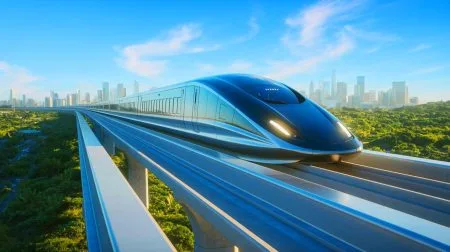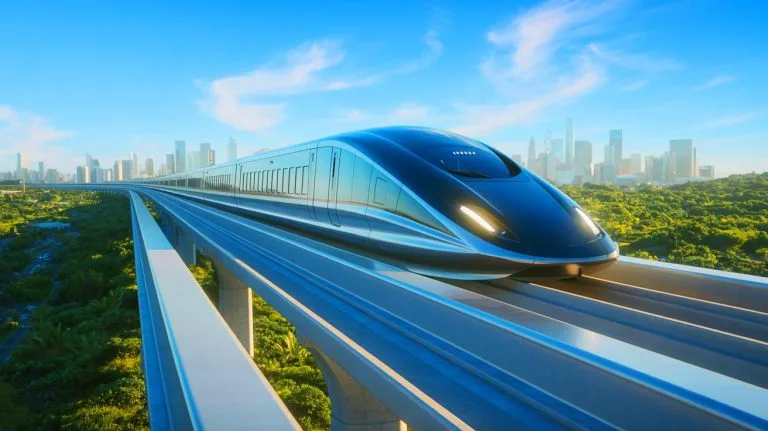| IN A NUTSHELL |
|
Imagine traveling at speeds comparable to a jet, but on land, in a train that glides silently above its tracks. This is the promise of magnetic levitation, or maglev, trains. While Japan and China have embraced this technology, achieving remarkable speed records, Western countries struggle to implement even conventional high-speed rail systems. The disparity raises intriguing questions about technological adoption and the future of transportation. How does maglev technology function, and why are Asian countries leading in its deployment?
From Bullet Trains to Magnetic Levitation
High-speed rail is not a novel concept in Asia. In 1964, Japan introduced the Shinkansen bullet trains, demonstrating that fast, safe, and efficient rail travel was achievable. Over the years, China has taken this technology further by constructing the world’s largest high-speed rail network. China’s network accounts for about two-thirds of global high-speed rail, with trains reaching speeds of 186 to 217 mph. This development set the stage for the next leap in rail technology: magnetic levitation.
In 2004, China launched the Shanghai Maglev line, the first commercial maglev train service, developed with German technology. This train connects Pudong Airport to downtown Shanghai, covering an 18.64-mile distance in just 7.5 minutes, reaching speeds of 268 mph. Meanwhile, Japan has been testing its superconducting maglev (SCMaglev) since the 1970s. In 2015, an experimental SCMaglev train set a world record at 374 mph. Japan is constructing a line between Tokyo and Nagoya, scheduled to open in the 2030s, which will reduce travel time from 100 minutes to just 40 minutes.
The Physics Behind Floating Trains
The core principle of maglev technology is magnetism. By utilizing powerful electromagnets, trains are lifted and propelled without touching the track, eliminating rolling resistance and allowing for high speeds and smooth travel. Two main maglev systems are in use today.
Why trucks remain essential for small businesses in the modern era
Electromagnetic Suspension (EMS): Used in Shanghai’s Transrapid system, EMS involves electromagnets under the train that pull it upward toward a steel track. The air gap is minimal, about 15 millimeters, and advanced sensors continuously adjust the magnet strength to keep the train stable, even at a standstill.
Electrodynamic Suspension (EDS): Japan’s SCMaglev employs superconducting magnets cooled to cryogenic temperatures. At low speeds, wheels support the train, but as it accelerates past 93 mph, the magnets create repulsive forces that lift the train about 4 inches above the guideway. The track acts as a linear motor, propelling the train forward.
Both systems ensure stability through magnet design and onboard controls. Remarkably, even at speeds above 300 mph, maglev trains maintain perfect alignment, offering a smooth ride.
How supercars are changing the face of automotive technology
The Passenger Experience
For passengers, traveling on a maglev train offers a unique experience. The absence of wheels on rails eliminates the usual noise and vibration associated with train travel. Acceleration is seamless, curves are stable, and the only significant resistance is air drag. Maintenance is also less frequent since there are fewer parts to wear out. However, the infrastructure costs are significant, as maglev systems require entirely new guideways rather than upgrades to existing tracks.
Despite these challenges, the passenger experience on maglev trains is unparalleled. The quiet, smooth ride transforms perceptions of rail travel, making it a competitive alternative to air travel for intercity routes, particularly in densely populated regions.
Asia vs. the West: Why the Gap?
In the United States, high-speed rail projects have faced significant challenges. The California high-speed rail project, intended to connect Los Angeles and San Francisco, has seen its costs soar from an initial $33 billion to over $128 billion, with only a short section under construction. A proposed maglev line between Washington, D.C., and Baltimore has been stalled due to environmental review issues.
In Europe, similar hurdles exist. Britain’s High Speed 2 (HS2) project has experienced cost overruns, and the northern section was canceled. Germany, despite pioneering maglev technology, has no operational high-speed maglev lines. Several factors contribute to Asia’s lead in this field. China prioritized high-speed rail as a national objective, investing heavily in its construction, while Japan steadily advanced its research and development efforts. The high population density in Asian megacities also creates significant demand for intercity travel, enhancing the economic viability of high-speed projects.
Additionally, cultural and industrial priorities play a role. China and Japan regard high-speed rail as a strategic industry, fueling innovation and potential exports. In contrast, the U.S. relies more on air travel and automobiles, while Europe tends to upgrade existing rail infrastructure instead of pursuing new maglev systems.
The Limits of Maglev
Despite its futuristic allure, maglev technology has limitations. The Shanghai maglev line, despite its record speeds, has not been extended due to high costs—over $1 billion for a mere 18.64 miles—and concerns about noise and electromagnetic effects. Most of China’s rail network still uses conventional high-speed trains, which are more cost-effective and adaptable.
Japan’s SCMaglev project has encountered delays due to environmental concerns, particularly regarding groundwater impacts. Even with the nation’s commitment, the Tokyo–Nagoya segment won’t be operational until at least 2034. Maglev technology also requires entirely new infrastructure, posing a significant financial challenge for many countries. For these reasons, upgrading existing rail systems remains a more practical solution for many regions.
Maglev trains represent a leap forward in transportation technology, offering unmatched speed and comfort. They illustrate how engineering innovation, when backed by political resolve and public investment, can revolutionize mobility. Looking ahead, will Western countries overcome their hurdles and embrace this cutting-edge technology, or will they continue to rely on traditional modes of transport?
Did you like it? 4.5/5 (27)








How can they keep the train from derailing at such high speeds? 🤔
Wow, 374 MPH? That’s faster than my morning coffee run! ☕️